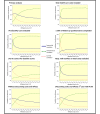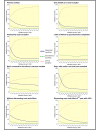Economic evaluation of a web-based tailored lifestyle intervention for adults: findings regarding cost-effectiveness and cost-utility from a randomized controlled trial
- PMID: 24650860
- PMCID: PMC3978559
- DOI: 10.2196/jmir.3159
Economic evaluation of a web-based tailored lifestyle intervention for adults: findings regarding cost-effectiveness and cost-utility from a randomized controlled trial
Abstract
Background: Different studies have reported the effectiveness of Web-based computer-tailored lifestyle interventions, but economic evaluations of these interventions are scarce.
Objective: The objective was to assess the cost-effectiveness and cost-utility of a sequential and a simultaneous Web-based computer-tailored lifestyle intervention for adults compared to a control group.
Methods: The economic evaluation, conducted from a societal perspective, was part of a 2-year randomized controlled trial including 3 study groups. All groups received personalized health risk appraisals based on the guidelines for physical activity, fruit intake, vegetable intake, alcohol consumption, and smoking. Additionally, respondents in the sequential condition received personal advice about one lifestyle behavior in the first year and a second behavior in the second year; respondents in the simultaneous condition received personal advice about all unhealthy behaviors in both years. During a period of 24 months, health care use, medication use, absenteeism from work, and quality of life (EQ-5D-3L) were assessed every 3 months using Web-based questionnaires. Demographics were assessed at baseline, and lifestyle behaviors were assessed at both baseline and after 24 months. Cost-effectiveness and cost-utility analyses were performed based on the outcome measures lifestyle factor (the number of guidelines respondents adhered to) and quality of life, respectively. We accounted for uncertainty by using bootstrapping techniques and sensitivity analyses.
Results: A total of 1733 respondents were included in the analyses. From a willingness to pay of €4594 per additional guideline met, the sequential intervention (n=552) was likely to be the most cost-effective, whereas from a willingness to pay of €10,850, the simultaneous intervention (n=517) was likely to be most cost-effective. The control condition (n=664) appeared to be preferred with regard to quality of life.
Conclusions: Both the sequential and the simultaneous lifestyle interventions were likely to be cost-effective when it concerned the lifestyle factor, whereas the control condition was when it concerned quality of life. However, there is no accepted cutoff point for the willingness to pay per gain in lifestyle behaviors, making it impossible to draw firm conclusions. Further economic evaluations of lifestyle interventions are needed.
Trial registration: Dutch Trial Register NTR2168; http://www.trialregister.nl/trialreg/admin/rctview.asp?TC=2168 (Archived by WebCite at http://www.webcitation.org/6MbUqttYB).
Keywords: Internet interventions; Web-based; computer-tailoring; cost-effectiveness; cost-utility; economic evaluation; lifestyle behaviors; randomized controlled trial.
Conflict of interest statement
Conflicts of Interest: Hein de Vries is scientific director of Vision2Health, a company that licenses evidence-based innovative computer-tailored health communication tools. No other authors reported any conflicts of interest.
Figures




References
-
- Ezzati M, Hoorn SV, Rodgers A, Lopez AD, Mathers CD, Murray CJ, Comparative Risk Assessment Collaborating Group Estimates of global and regional potential health gains from reducing multiple major risk factors. Lancet. 2003 Jul 26;362(9380):271–80. - PubMed
-
- Landelijke nota gezondheidsbeleid National Government, 2011. [2013-12-01]. Gezondheid dichtbij Health nearby http://www.rijksoverheid.nl/bestanden/documenten-en-publicaties/notas/20....
Publication types
MeSH terms
Associated data
LinkOut - more resources
Full Text Sources
Other Literature Sources
Miscellaneous

